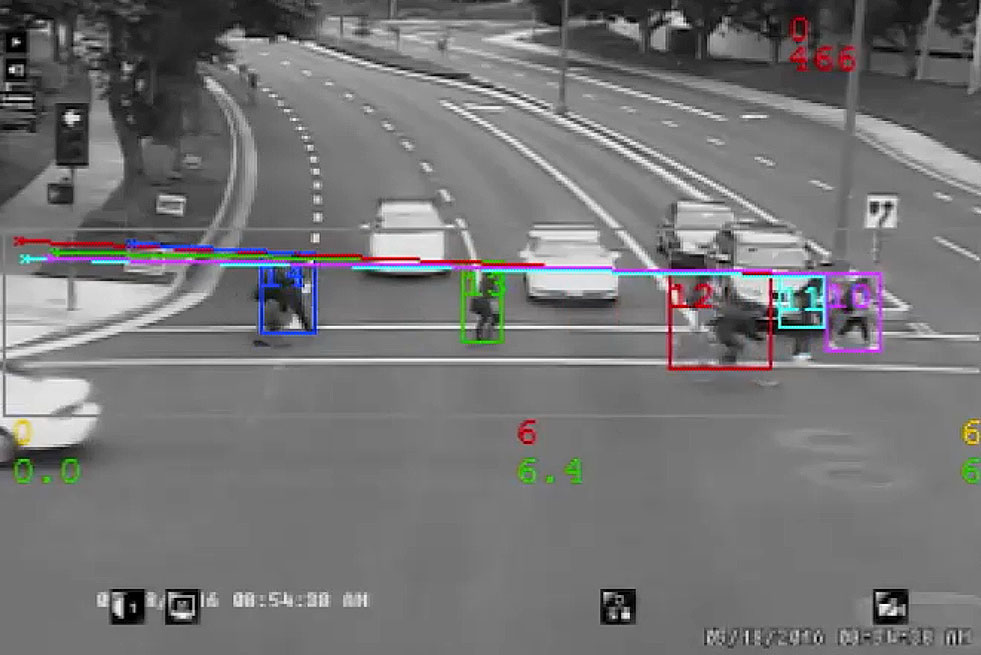
Detection Algorithm Improvements for Enhanced Traffic Flow and Safety – Part 2: Pedestrian and Bicycle Safety

In the second of his three-part blog series that will explain how improvements to detection algorithms are enhancing traffic flow and safety at the intersection, Iteris’ Michael Whiting focuses on pedestrian and bicycle detection and differentiation.
I lived in the Netherlands for two years before moving to the United States. During that time, I learned that the Dutch are serious cyclists, most having a daily ride to and from work, as well as when running errands or taking weekend trips to the countryside.
The Dutch generally do not wear safety helmets. When I asked why, they told me that “it’s against the law to knock someone off their bike.” I would respond with: "but if a vehicle were to collide with the cyclist, wouldn’t he or she be badly injured?” Surprisingly, my Dutch co-workers could not grasp my concern for safety. Their logic was: "if it is against the law, then we must be safe."

I am not a big cyclist, but I am an avid walker. Having ruined my knees playing Sunday soccer on poorly maintained fields, walking is my primary form of exercise. Unfortunately, where I live in southern California, motorists are not used to seeing many pedestrians or cyclists and are somewhat oblivious to us or consider us a nuisance.
Why does this all matter to Iteris and our detection systems?
For me, pedestrian and bicycle safety are personal priorities. At Iteris, we have the technology to help communities address safety issues and directly benefit this group of vulnerable road users (VRUs).
Many factors are in play:
- There are an increasing number and variety (e.g., scooters, hoverboards) of VRUs
- Agencies nationwide are implementing Vision Zero initiatives to eliminate all traffic fatalities
- Increasing regulations at the city, state and federal levels require more accurate data to make better-informed decisions
By accurately detecting, differentiating and counting VRUs, Iteris can be a valuable component in all three of the efforts listed above. For example, detection can be used in real time to send safety alerts to connected vehicles to warn drivers of VRUs. Longer term, traffic engineers and planners can use the year-round multimodal data that are automatically collected by our sensors to identify where dollars can best be spent to prioritize projects and improve safety for all road users.
How do we distinguish bikes from vehicles, and why does it matter?
Iteris’ detection systems have always been able to detect bicycles. But what makes the difference when making critical life-saving decisions is the ability to differentiate cyclists from other road users. Differentiation or discrimination ensures that they are accurately identified as a bicycle and given enough green-time clearance to cross the intersection safely.
One of the first things we learned in developing SmartCycle, the bike detection and differentiation feature that is available in Iteris’ latest video detection platforms, is that bikes approaching the stop bar do not follow the same road rules as vehicles.

Figure 1 Cyclist behavior previously presented challenges in detecting and discriminating from vehicles
To account for the unique and sometimes unpredictable nature of cyclists, we create and extend vehicle lanes based on the drawn detection zones, and then begin tracking all objects as they enter the field of view before starting to make decisions about them. Do they have vehicle attributes (e.g., size, speed, edges), or do they have bike attributes?
As objects move towards the stop bar, these attributes are continuously reviewed until an object can be confirmed or rejected as a bicycle. We also associate a cyclist to the nearest drawn bike zone to overcome the common behavior of splitting lanes.
![]()
Figure 2 Algorithm detects and tracks cyclists
The accurate detection and differentiation of a bicycle ensure that the cyclist will still get their green light, and avoid having to cross busy vehicle lanes to dismount and hit a ped button. Agencies can also install a supplementary safety device such as our bike detection indicator to provide positive feedback and peace of mind to the cyclist that they have been detected.
The challenge of accurately detecting pedestrians
Iteris began detecting pedestrians in 2016 with the release of PedTrax, another feature embedded in our latest platforms. However, detecting and identifying pedestrians in the crosswalk required a whole new way of thinking from an algorithm viewpoint.
Up until 2016, everything engineering developed expected objects to flow from the top of the video screen to the bottom. In fact, we used these trajectories going in the reverse direction or from side to side as a method to reject objects for detection purposes.
Detecting pedestrians meant that we had to change this way of thinking to accept the side-to-side movement. However, this was not enough as there was also cross traffic in the field of view and the system still needed to reject that.

Figure 3 Crosswalk identified by algorithm based on stop-bar detection zones
The novel solution was to identify the crosswalk area based on the stop-bar vehicle detection zones' positioning. Within the strip, the algorithm applies different logic to analyze various attributes, including object speed, size and shape, to confidently identify an object as a pedestrian, similar to how the algorithm identifies cyclists.
Whenever at an intersection, I am filled with a sense of pride seeing Iteris sensors installed, knowing that we are helping keep people safe.
![]()
Figure 4 Multipath tracking algorithm detects various modes
In part three of this blog series, I will focus on how the vehicle, pedestrian and bicycle detection algorithms combined with radar and future technologies will enhance safety and mobility.
About the Author

Michael Whiting is VP, Engineering, Advanced Sensor Technologies at Iteris.
Connect with Michael Whiting on LinkedIn
 X
(Twitter)
X
(Twitter)
 Facebook
Facebook LinkedIn
LinkedIn Copy
Link
Copy
Link Email
Email

